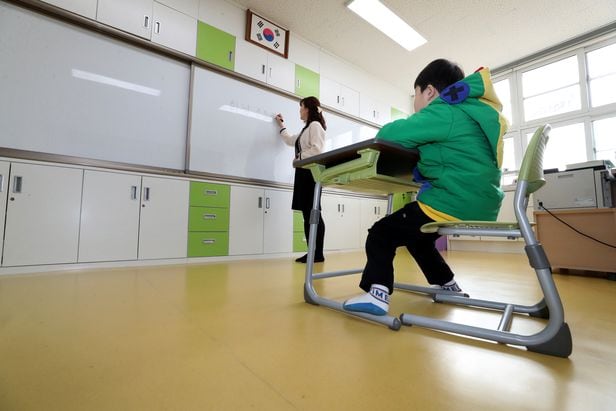 |
| Yang Geun-woo, who completed the entrance ceremony at Hoenam Elementary School in Boeun-gun, North Chungcheong Province, on the morning of the 4th, is taking classes in the first grade classroom. There are a total of 12 students at this school, and only 1 student enrolled on this day. /Reporter Shin Hyeon-jong |
Analysis has shown that in seven years, half of Korea's citizens will be over 50 years old. In 9 years, the number of elementary school students (age 7) will be reduced to half of the current level, and in 14 years, the number of men (age 20) entering the military will not reach the 200,000 known minimum level of military personnel. This is an aftereffect of population decline due to low birth rates and aging.
The Korean Peninsula Future Population Research Institute announced on the 6th that it had published the ‘2024 Population Report’ with these contents. This report also includes a ‘future population chronology’ that summarizes 14 population problems that our country will face over the next 40 years.
The report predicts that the number of children (total fertility rate) expected to be born per Korean woman in her lifetime will decrease to 0.65 next year. This means that it falls further from last year’s total birth rate (0.72 people).
The average age in our country is increasing, and in 7 years, half of the population will be over 50 years old. Last year, the median age (the age of the person in the center when the entire population is sorted by age) was 45.5 years old, but it is expected to rise to 50.3 years in 2031.
Two years later, the number of elementary school students (age 7) is cut in half due to the low birth rate. Last year, the number of elementary school students was 430,000, but it is expected to decrease to 220,000 in 2033. Many elementary, middle, and high schools will inevitably face the risk of closure.
Following this, the number of men (age 20) entering the military is decreasing. Currently, in order to maintain our country's military, at least 200,000 people must enlist as active-duty soldiers every year. Last year, there were 260,000 20-year-old men eligible for active duty military service, but the number is expected to fall to 190,000 in 2038, falling below the 200,000 mark.
The Korean Peninsula Future Population Research Institute was launched in October 2022 as a private organization that studies Korea's population changes and response measures. Former Prime Minister Chung Un-chan serves as the chairman, and former Statistics Korea Director Lee In-sil serves as the director. This is the first time the researcher has published a population report.
The working age population (ages 15 to 64), which was 36.57 million last year, is expected to decrease to 27.17 million in 2044. The working population has decreased by 10 million in 20 years. If the number of people working decreases, the number of people spending money also decreases, shaking the foundation for economic growth.
The number of people who can work is decreasing, but the elderly population is increasing, increasing the burden of support for the younger generation. In 2050, Korea's elderly population (age 65 or older) is expected to account for 40% (18.91 million) of the total population. At this time (2049), one in five households (20.2%) in Korea is expected to be a household with an elderly person living alone. Therefore, in 2058, one young person who can work will support one elderly person or child. Currently, 2.5 young people support one elderly person or child.
After about 35 years, the number of people dying will be five times greater than the number of people being born. In 2060, the expected number of deaths in Korea is 746,000 and the expected number of births is 156,000, resulting in a natural decline in the population of 590,000. Cradles are empty and crematoriums are becoming scarce. Last year, Korea's naturally declining population was 123,000.
By 2061, one in five Koreans is expected to be over 80 years old. Last year, the population aged 80 or older was only 2.29 million, but it will increase to 8.49 million in 2061. Ultimately, Korea's population is expected to reach the 30 million range (39.69 million) in 2065.
The report proposed an 'immigration policy that allows foreigners to settle' as a solution to the population problem. The point is that we should allow foreigners to settle down and live in our country, rather than just come into our country, make money, and then leave. He also said that we should create a country where people who live together without marriage can have children with legal support. Lee In-sil, director of the Korean Peninsula Future Population Research Institute, said, “The disaster caused by population decline is an issue that depends on the existence of the Republic of Korea,” and added, “Once the golden time for population recovery passes, a lot of time and money will be needed for our society to return to a stable state.”
No comments:
Post a Comment